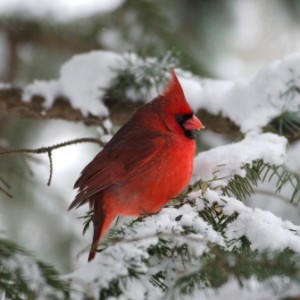 There may be no lovelier sight in the winter that a dashing red Northern cardinal perched on a snowy evergreen bough. Quintessential of life in the Adirondacks, the Northern cardinal has long been admired for its bright plumage and distinctive, cheery chirp. If you’re looking for cardinals this winter – or want to attract them to your home feeder – here are a few facts about this beautiful bird that can help.
There may be no lovelier sight in the winter that a dashing red Northern cardinal perched on a snowy evergreen bough. Quintessential of life in the Adirondacks, the Northern cardinal has long been admired for its bright plumage and distinctive, cheery chirp. If you’re looking for cardinals this winter – or want to attract them to your home feeder – here are a few facts about this beautiful bird that can help.
These mid-sized songbirds are often seen in pairs – the bright, crimson male and his less showy brownish-red counterpart. This is because unlike most birds, cardinals mate for life. And once mated, they rarely part ways – usually if you spot the male, the female is nearby.
Male cardinals are generally bright red overall, with a distinctive black mask and throat. They have a prominent red crest, and their bill is large, thick and orange-red. As mentioned above, the females are far less brilliant, with a muddy red color overall, with a slightly more distinctive red on wings, tail and crest. Like the male, the female has a darker mask on the face and throat, with a orange-red beak.
Generally speaking, cardinals lay eggs between spring and summer, their nests mostly being found in hedges and thickets. Usually females lay between two and five eggs, sometimes two to four times per season. Once, the cardinal was prized as a pet, but has not been sold as a caged bird since the Migratory Bird Treaty Act of 1918.
Cardinals are omnivorous, meaning they eat a variety of foods, including bugs, fruit, berries, seeds, and all the delicious treats you leave them at their feeder, including wild bird mix and suet. They favor any kind of sunflower seed but have a preference for the black oil seeds. You’re much more likely to see cardinals at your feeder if you provide this type of food.
If you want to bring cardinals to your feeder this winter, stop by Charlie Johns in Speculator. There you’ll find a variety of wild bird food, including the sunflower seeds you need to draw the Adirondack’s cheeriest guest to your backyard feeder.
